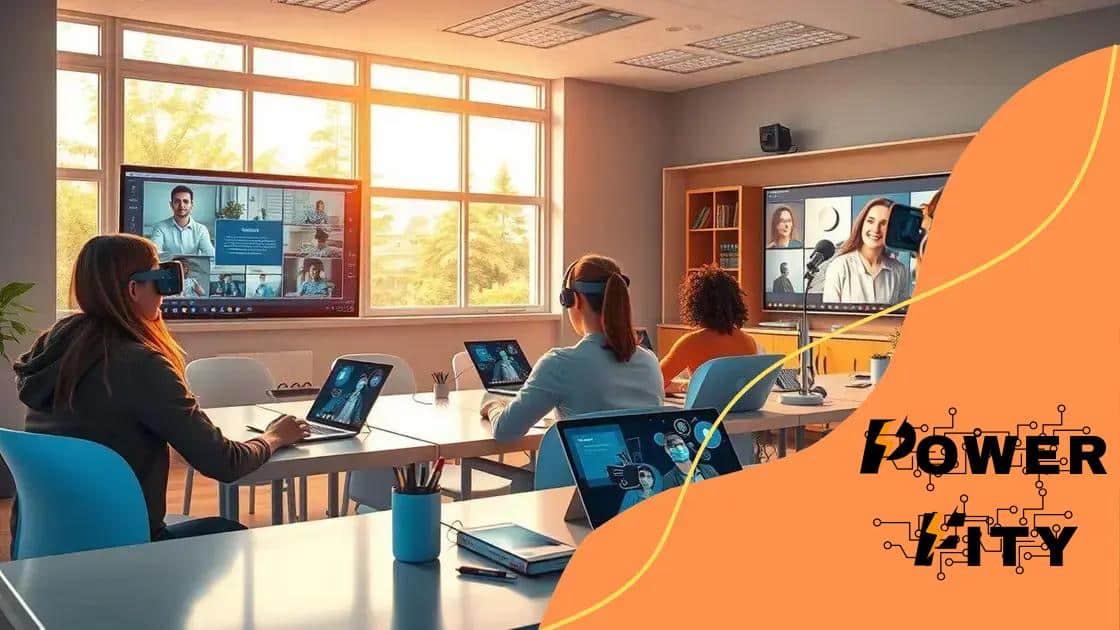Innovations in remote learning technologies are changing education

Innovations in remote learning technologies enhance education by providing personalized learning experiences, increasing student engagement, and facilitating collaboration, while preparing students with essential future skills.
Innovations in remote learning technologies are reshaping our educational landscape. Ever wondered how these advancements impact learning experiences? Let’s dive into the possibilities.
Emerging tools in remote learning
As education transforms, emerging tools in remote learning are at the forefront of these changes. These tools not only enhance engagement but also make learning more accessible for everyone.
One groundbreaking tool is the virtual classroom. It simulates a real classroom experience, allowing students to interact with peers and teachers from various locations. This enhances collaboration and promotes a more social learning environment.
Interactive Learning Platforms
Interactive platforms like Kahoot! and Quizlet are becoming essential for online learning. These tools make lessons fun and engaging.
- They provide instant feedback.
- Students can learn at their own pace.
- Interactive elements promote retention of information.
Another essential tool is video conferencing software. Programs like Zoom and Microsoft Teams offer features like breakout rooms and live chats. These foster a more interactive experience than traditional lectures and help build community.
Learning Management Systems (LMS)
A Learning Management System, such as Moodle or Canvas, centralizes all course materials. Students can easily access resources, submit assignments, and track their progress. This streamlines educational processes and keeps students organized.
Additionally, the rise of gamification in learning tools is noteworthy. By integrating game-like elements into the learning process, students are motivated to participate and achieve their goals.
Incorporating these emerging tools in remote learning not only makes education more engaging but also empowers students to take control of their learning journey. These tools are reshaping how we perceive and partake in education worldwide.
Benefits of remote learning technologies
The benefits of remote learning technologies are vast and impactful. These advancements have changed the way students and educators approach education, offering convenient and flexible options.
One significant advantage is accessibility. Students from all backgrounds can join classes from anywhere with an internet connection. This inclusivity allows for greater participation and diversity in educational environments.
Flexibility and Convenience
Remote learning technologies provide flexibility that traditional settings often lack. Students can learn at their own pace and choose the time that best fits their schedules.
- Access to recorded lectures is a game changer.
- Students can review materials as needed.
- This accommodates different learning styles effectively.
Another key benefit is the use of multimedia resources. Videos, interactive quizzes, and virtual simulations enrich the learning experience. These tools help to keep students engaged and motivated throughout their studies.
Cost-Effectiveness
Many remote learning options are more affordable than traditional in-person classes. Students save on commuting costs and materials, as many resources are available online for free or at a reduced price.
The benefits of remote learning technologies extend to educators as well. Teachers can utilize analytics from learning management systems to monitor student progress and tailor their instruction accordingly. This data-driven approach enhances the learning process for everyone involved.
Overall, embracing these technologies not only improves educational access and engagement but also prepares students for a future where digital skills are essential in the workforce.
Challenges faced by educators

Educators face many challenges in remote learning as traditional classroom dynamics shift. These challenges can impact both teaching effectiveness and student engagement.
One major issue is the lack of personal interaction. Teachers often miss the in-person connections that help foster a supportive learning environment. This distance can make it difficult to gauge student understanding and emotional well-being.
Technical Difficulties
Technical issues are another significant challenge. Not all educators possess the same level of comfort with technology. When software fails or internet connections are poor, it disrupts the learning experience.
- Teachers may struggle with troubleshooting technical problems.
- Students might miss out on vital lessons if they cannot connect properly.
- Not all students have access to reliable technology, creating inequality.
Additionally, managing a virtual classroom can feel overwhelming. The dynamic of monitoring students and ensuring participation demands heightened attention. Some teachers find it hard to maintain student engagement when lessons are delivered through screens.
Adapting Curriculum
Another challenge involves adapting the curriculum to fit a virtual format. Some subjects are more suited to remote learning than others. Teachers must find new ways to design engaging lessons that still meet educational standards.
Asynchronous learning, where students learn on their own time, poses its own set of challenges. While it offers flexibility, it can make it tough for teachers to ensure that students complete assignments and stay motivated.
Educators are continually adapting to these challenges. By addressing these issues, they can enhance the remote learning experience for all students and create a more balanced approach to education.
Future trends in remote learning
The future trends in remote learning indicate significant changes in how education is delivered. As technology advances, the ways we learn and teach are evolving rapidly.
One prominent trend is the integration of artificial intelligence. AI tools can personalize learning experiences based on individual student needs. This approach allows for tailored resources and recommendations, making learning more efficient and effective.
Virtual and Augmented Reality
Another exciting development is the use of virtual reality (VR) and augmented reality (AR) in education. These technologies create immersive learning environments that can bring subjects to life.
- Students can explore historical sites without leaving their homes.
- Science experiments can be conducted safely in a virtual lab.
- VR and AR facilitate hands-on experiences that engage students more deeply.
Additionally, the rise of collaborative tools is shaping remote learning. Platforms like Google Workspace and Microsoft Teams enable real-time collaboration on projects. This fosters teamwork skills and allows students to learn from each other, even when apart.
Flipped Classrooms
The flipped classroom model is gaining traction. In this approach, students learn new content at home through videos or readings and then apply this knowledge during live sessions. This method encourages active participation and deeper understanding.
Moreover, the emphasis on social-emotional learning is increasingly important in remote settings. Educators are looking for ways to support students’ mental health and well-being during online learning.
As we anticipate the future trends in remote learning, it is clear that these innovations will continue to shape education. By embracing technology and innovative teaching methods, we can create a more inclusive and effective learning environment for everyone.
How students benefit from innovative technologies
Students gain many advantages from the use of innovative technologies in education. These tools not only enhance learning but also make education more accessible and engaging.
One major benefit is personalized learning. Technology allows educators to tailor lessons to meet the needs of individual students. Through adaptive learning systems, students can progress at their own pace, ensuring they fully understand the material before moving on.
Enhanced Engagement
Innovative technologies also increase student engagement. Tools like interactive simulations and gamified learning platforms make lessons more interesting.
- Students are more likely to participate when lessons are interactive.
- Games and challenges help reinforce concepts.
- Visual and auditory elements cater to different learning styles.
Additionally, access to a wide range of resources is another critical advantage. Students can explore topics in depth through videos, articles, and online courses that are often available for free or at low cost.
Collaboration Opportunities
Collaboration is easier with technology. Students can work together on projects regardless of their location, using tools like Google Docs or virtual meeting apps.
This collaboration fosters teamwork and communication skills, essential for the modern workplace. Students learn to share ideas effectively and learn from one another as they solve problems together.
Moreover, innovative technologies prepare students for the future job market. Familiarity with tools like coding software and digital design programs builds valuable skills that employers seek.
The benefits of using innovative technologies in education are immense. By incorporating these tools into their learning processes, students not only enhance their current education but also equip themselves with skills necessary for their future careers.
FAQ – Frequently Asked Questions about Innovations in Remote Learning Technologies
How do personalized learning technologies benefit students?
Personalized learning technologies enable students to learn at their own pace, ensuring they fully understand the material before progressing, which improves overall learning outcomes.
What are the advantages of using gamified learning platforms?
Gamified learning platforms enhance student engagement by making lessons more interactive and enjoyable, encouraging participation and retention.
How does technology facilitate collaboration among students?
Technology allows students to collaborate on projects in real time, regardless of location, promoting teamwork skills and enhancing learning experiences.
What future skills can students develop through innovative technologies?
Innovative technologies prepare students for the future job market by helping them develop digital skills, critical thinking, and problem-solving abilities necessary for modern careers.





